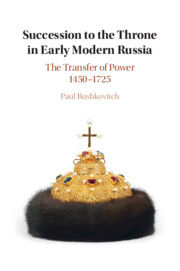Book contents
- Succession to the Throne in Early Modern Russia
- Succession to the Throne in Early Modern Russia
- Copyright page
- Contents
- Preface
- Acknowledgments
- 1 Succession to the Throne, Autocracy, and Absolutism
- 2 Designation and Heredity 1450–1533
- 3 Benediction to Election 1533–1598
- 4 Election and Heredity 1598–1645
- 5 Succession and the New Culture of the Court 1645–1689
- 6 Peter the Great and Succession 1690–1719
- 7 Peter’s Heirs and Feofan Prokopovich 1719–1725
- Epilogue and Conclusion
- References
- Index
4 - Election and Heredity 1598–1645
Published online by Cambridge University Press: 29 March 2021
- Succession to the Throne in Early Modern Russia
- Succession to the Throne in Early Modern Russia
- Copyright page
- Contents
- Preface
- Acknowledgments
- 1 Succession to the Throne, Autocracy, and Absolutism
- 2 Designation and Heredity 1450–1533
- 3 Benediction to Election 1533–1598
- 4 Election and Heredity 1598–1645
- 5 Succession and the New Culture of the Court 1645–1689
- 6 Peter the Great and Succession 1690–1719
- 7 Peter’s Heirs and Feofan Prokopovich 1719–1725
- Epilogue and Conclusion
- References
- Index
Summary
Tsar Boris Godunov had a designated heir but was overthrown by the First False Dmitrii, and his son perished in the Time of Troubles. The false Dmitrii claimed to be the son of Ivan the Terrible and the true heir. After the people of Moscow had overthrown and killed Dmitrii, the boyar elite elected as tsar Vasilii Shuiskii. After further disorder, the Polish king Zygmunt III imposed his son Władysław on the Russian throne by a forced election, but the militia under Prince D. M. Pozharskii and the merchant Kuzma Minin defeated the Polish forces. In 1613 an Assembly of the Land elected Michael Romanov as tsar. Tsar Michael did not marry until his father, Filaret, Patriarch of the Orthodox Church, returned to Russia in 1619. After Michael’s marriage to Evdokiia Streshneva in 1626, he fathered many children, including his heir Aleksei. Michael followed the older procedures, requiring oaths to the whole family and demonstrating his choice of heir by giving his oldest son a role in court ceremonies. At no point did the Russians suggest that election was in any way inferior to heredity in succession to the throne.
Keywords
- Type
- Chapter
- Information
- Succession to the Throne in Early Modern RussiaThe Transfer of Power 1450–1725, pp. 121 - 181Publisher: Cambridge University PressPrint publication year: 2021



